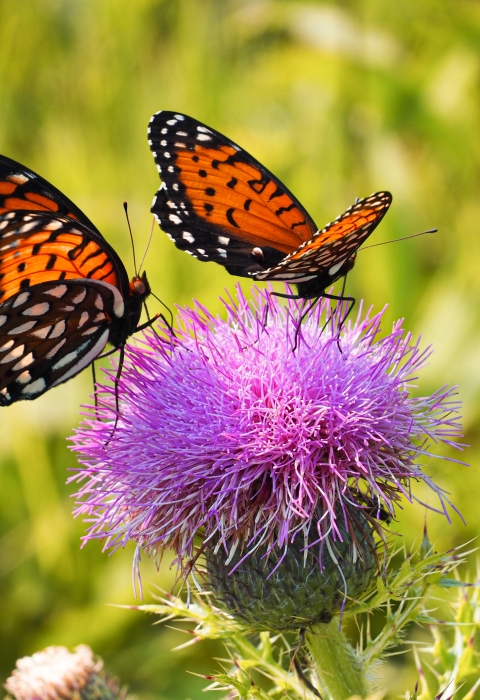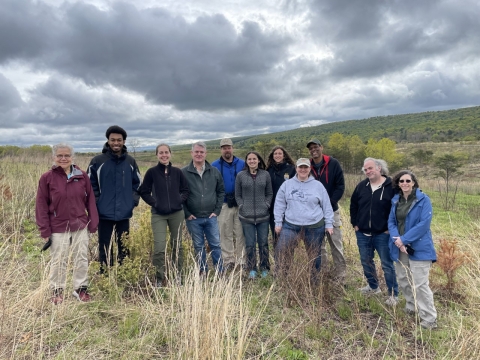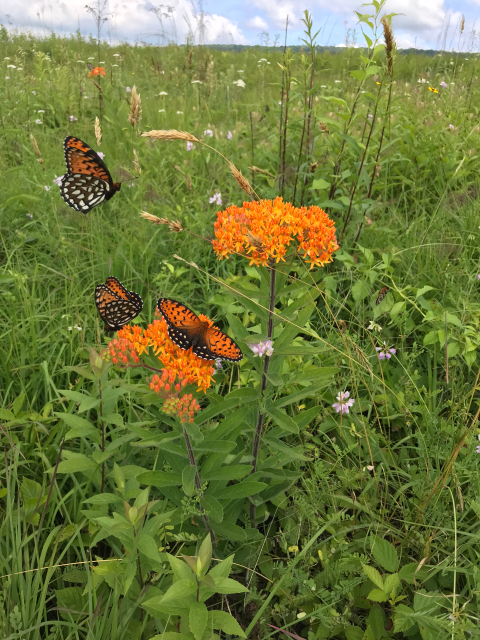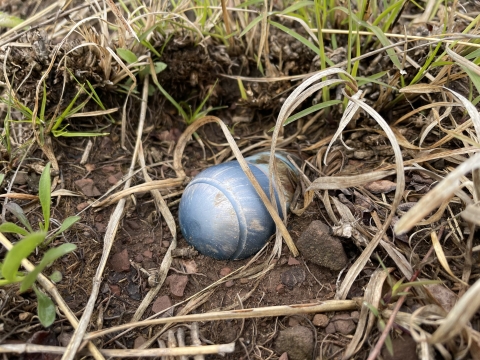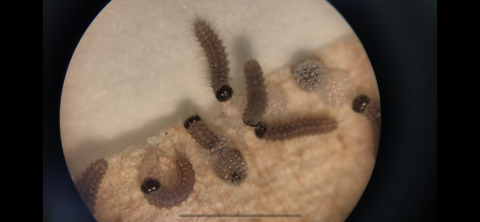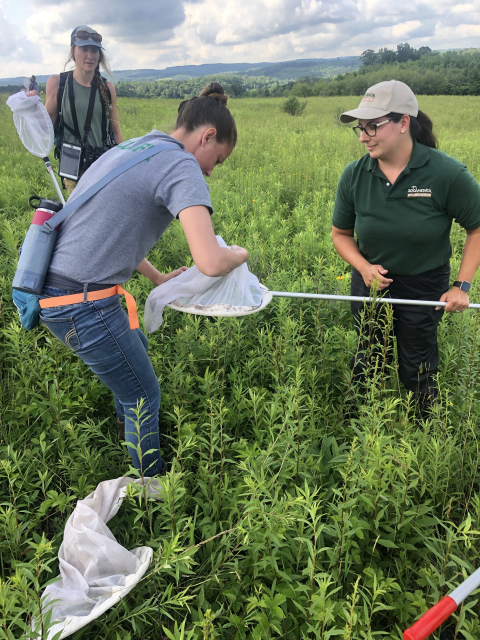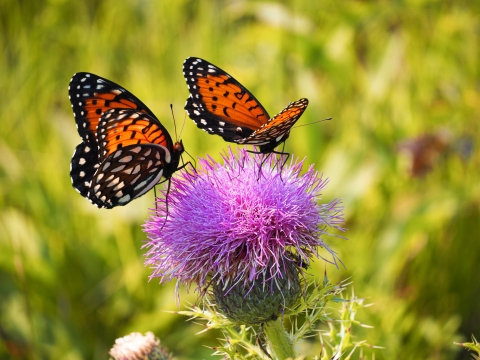On a raw morning in early May, a dozen biologists from the U.S. Fish and Wildlife Service and Fort Indiantown Gap piled out of pickup trucks under gunmetal-gray skies and walked gingerly onto an artillery range. Tiptoeing amidst spent ammunition shells and bunches of thigh-high straw-colored grass, they scanned the ground for something small, delicate, and bright: spring's first violet blossoms.
Violets are an important part of a well-balanced diet for the regal fritillary, a rare butterfly the Service is considering listing under the Endangered Species Act. Just as infants need milk or formula, the butterfly’s caterpillars need these ground-hugging flowering plants to grow. To complete their complex lifecycles, fritillaries also need nectar sources that sustain adults, and native grasslands with tall vegetation that provide shelter for all life stages.
While the western subspecies of the regal fritillary is still found in native grasslands that meet these needs in 14 states in the Great Plains and portions of the Midwest, the eastern subspecies is found only at Fort Indiantown Gap. The National Guard Training Center in central Pennsylvania is the last place in the eastern U.S. that still provides this habitat sweet spot.
It’s not a coincidence.
New recruits
Spring is the start of military training season at the fort. Over the next few months, tens of thousands of soldiers will cycle through the installation to practice tactical maneuvering of mechanized infantry, air-to-ground bombing and strafing, and the use of individual and crew-served weapons.
It’s also when the fort’s smallest recruits show up. As the weather warms, larvae half the size of a grain of rice begin to stir in the grasses, waking from their winter dormancy to eat violets, grow and pupate.
In June and July, they emerge from chrysalises and mate, relying on nectar sources for sustenance. In late summer and early fall, the female butterflies lay eggs.
When the eggs hatch, the first stage larvae — called first instar — eat their own egg cases, their only meal before overwintering on the range until spring, when the busy season starts again.
This rare butterfly persists on the site’s artillery ranges not in spite of the mortar fire and rumbling tanks but because of them. Protected from development for decades and disturbed regularly by military training activities, the installation’s 17,000 acres — slightly larger than Manhattan — provide a mosaic of high-quality habitats, including one of the largest expanses of native warm-season grasslands in the Northeastern U.S.
“If the military wasn’t present here, these biodiverse native ecosystems would not exist,” said Erika McKinney, a wildlife biologist with Fort Indiantown Gap.
Neither would the eastern regal fritillary. Their habitat requires periodic disturbance, at the right time and intensity, to keep the butterfly going strong.
Common ground
Unlike the soldiers who share their habitat, adult eastern regal fritillaries aren’t well camouflaged. These large, showy butterflies have bright orange forewings with black spots and dark hindwings that feature black bars, fine white markings, and two rows of large spots at the base.
But the soldiers and butterflies do share common ground, literally.
"They both need ranges,” McKinney said. Soldiers need wide open spaces to train, and fritillaries need ranges to roam. “They are nomads in their ecosystem.”
The soldiers’ training activities improve the butterflies’ habitat by creating regular disturbances — think controlled fiery explosions — that sustain grassland habitats, by both keeping woody vegetation from encroaching and providing the right conditions for native nectar plants to flourish. Violets in particular thrive in disturbed soils.
For a long time, the eastern regal fritillary was able to hang on at the installation solely because of military training activities. Then in 1992, the National Guard began actively managing the species’ habitat through prescribed burns, mowing, seeding and transplanting to further optimize the landscape for a species that seemed to be disappearing everywhere else.
“They had the foresight to realize the fort might be the only place left for this species,” said Pam Shellenberger, a biologist with the Service’s Pennsylvania Field Office. “They launched this incredible effort and now do deliberate management in five research areas on the fort for the fritillary.”
The habitat has responded. Surveys show violet density increases four-fold after an area has been trampled by tanks. After a prescribed burn prescribed burn
A prescribed burn is the controlled use of fire to restore wildlife habitat, reduce wildfire risk, or achieve other habitat management goals. We have been using prescribed burn techniques to improve species habitat since the 1930s.
Learn more about prescribed burn , the increase is eightfold. Regular prescribed burns ensure the violets keep coming.
Fortifying the fritillary
While Fort Indiantown Gap has become a stronghold for the eastern regal fritillary, the species’ isolation there leaves it vulnerable to forces beyond the military’s control. Imagine if a disease that affects butterflies broke out on the installation. Without healthy populations in other locations, the species has no reinforcements in the face of disaster.
Climate change adds to the challenge. Changes in temperature and moisture could impact caterpillar survival, as well as bloom times and overall productivity of violets and other native wildflowers the eastern regal fritillary depends upon.
In 2011, the National Guard joined forces with ZooAmerica to experiment with raising butterflies in captivity. With funding from the Pennsylvania Wild Resources Conservation Fund, the zoo, based in nearby Hershey, Pennsylvania, developed a captive-rearing laboratory that serves as a sort of maternity ward for butterflies.
Each August, gravid females — those carrying eggs — are transported to the lab and placed in white paper bags furnished with strips of paper to replicate grass, moist cotton balls to provide humidity, and violet leaves to stimulate egg laying.
The resulting eggs are placed in petri dishes and hydrated daily. When larvae hatch, they’re moved into overwintering containers and kept near freezing until spring.
In the spring, some larvae are kept in the lab for research, but, up until recently, most have been released to complete their life cycles in the wild.
The experiment has paid off. Over the last 12 years, the lab has brought in 88 females from the installation that have produced 131,322 eggs, with 82% hatching into larvae.
That’s a success by any measure. But the partners also have their sights on a bigger goal.
Expanding horizons
Knowing how to raise eastern regal fritillaries in captivity gives biologists a tool to bolster the population at Fort Indiantown Gap. But it doesn’t solve the isolation problem. That’s why the National Guard has also been working with partners — including the Pennsylvania Game Commission, the Service, ZooAmerica, Temple University, Pennsylvania Western University, and Penn State Dubois — to identify and establish new sites in the state where the species can thrive.
It’s been an uphill battle. While they have found other sites with the right habitat, a key ingredient was always missing. Either the violets, bunch grass, and other native nectar sources weren’t abundant or dense enough to support a population of a butterfly that can lay thousands of eggs at a time and likes to roam. Or there was no capacity for long-term management needed to maintain the habitat.
The partners are now focusing on an area managed by the Pennsylvania Game Commission that they hope will offer the greatest return-on-investment of staff time — planting violets, seeding nectar plants and conducting prescribed burns — and fritillaries.
The site is an abandoned surface mine with a similar look and feel to the ranges at Fort Indiantown Gap. “It’s this barren landscape that has regenerated with pollinator plants and grasslands,” Shellenberger said. “If you look in the space between the grasses you can see that rocky well-drained soil that violets like."
Last spring, they released 877 caterpillars at the site. In early summer, biologists from the Service’s Science Applications program and Pennsylvania Field Office made multiple trips to the remote location to help partners look for adult butterflies — marking those caught to avoid double counting.
“We captured 12 adults, which is not bad!” McKinney said.
A team from Science Applications, Fort Indiantown Gap, and Pennsylvania Western University also conducted vegetation surveys to assess availability of violets and nectar plants at the site, based on the gold standard for habitat, the National Guard Training Center.
“We’re always comparing to Fort Indiantown Gap, where we know it does so well,” she said.
Always ready, always there
In tandem with its boots-on-the-ground efforts to conserve the eastern regal fritillary, Fort Indiantown Gap collaborated with the Service to develop a Candidate Conservation Agreement that codifies its intentions to conserve the species. The formal-but-voluntary commitment was finalized in mid-February and will now be appended to the installation’s Integrated Natural Resource Management Plan, which identifies key natural resources and actions needed to manage them.
“The agreement outlines the beneficial management practices the fort has been doing to help the eastern regal fritillary,” Shellenberger said.
If the species is listed, the agreement will help streamline the consultation process between the Department of Defense and the Service required under the Endangered Species Act to provide coverage for incidental loss of some individuals resulting from activities that benefit the species.
The goal is to avoid disrupting decades of conservation progress that the eastern regal fritillary can’t afford to lose.
"If not for management conducted by the military, this species would already have blinked out,” she said.
True to their motto, the National Guard plans to be “Always Ready, Always There” for the eastern regal fritillary at Fort Indiantown Gap.
